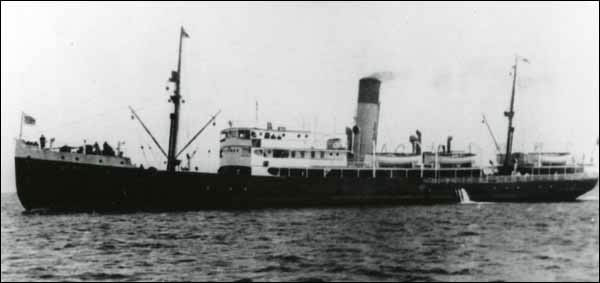On 14 October 1942, 78 years ago, at 3:40 am, the Newfoundland passenger ferry SS Caribou was torpedoed by the German submarine U-69 37 km (20 nmi) southwest of Port aux Basques, Newfoundland, and sunk five minutes later. 137 people died, including civilian woman/children, Captain Benjamin Taverner, the long-time ship’s captain, and his sons Stanley and Harold, who served as first and third officers, respectively. Her sinking and large death toll made it clear that the war had really arrived on the home front of Canada and Newfoundland, and is cited by many historians as the most important sinking during the Second World War in Canadian-controlled waters.
SS Caribou was constructed for the Newfoundland Railway in 1925 at Rotterdam, Netherlands. Launched in 1925, the Caribou had a capacity of 3,000 horsepower (2,200 kW) and was able to attain a speed of 14.5 knots (26.9 km/h) when fully loaded. Between 1928 and 1942, the SS Caribou was a Newfoundland Railway passenger ferry running between Port aux Basques, in the Dominion of Newfoundland, and North Sydney, Nova Scotia. She was considered a luxury ferry for the times, due to the fact she had electric lights and steam heat in all the rooms. In addition, Caribou also helped during the seal hunt along the Newfoundland coast every spring due to its ice-breaking design.
On 13 October 1942, SS Caribou was part of the convoy Sydney-Port aux Basque (SPAB), organized by HMCS Defender, a Royal Canadian Navy base. The SPAB convoy series normally occurred three times a week and was carried out in the dark. The naval escort vessel on this ill-fated voyage was HMCS Grandmère, a Bangor-class minesweeper. Sadly, the German submarine U-69 was patrolling the Gulf of St. Lawrence. It was a dark evening and the U-69 was silhouetted against the night horizon by the thick smoke from the coal-fired steam boilers of the Caribou. Grandmere saw the submarine and attempted to ram it, but the U-69 submerged. The minesweeper (Grandmere) launched six deep charges over the next two hours but did not damage the submarine and U-69 crept away undetected into the Atlantic. Following procedure, Grandmère then went back for survivors.
The Canadian naval vessel Grandmere was criticized in the Sydney Post-Record and The Globe and Mail as well as other media outlets in the days after the sinking for not stopping and helping save survivors immediately; but it was against operating protocols, and would have put her in immediate danger of being sunk as well. Grandmère sailed for Sydney, Nova Scotia after picking up survivors because it had better hospital facilities than Port aux Basques, Newfoundland.
It was suggested by Gordon Payne, listening to the lyrics of the song, that it was composed by someone who was on The Caribou when it sunk. Many years ago, he heard a portion of the song and later got the full version of Cox’s Cove from Eli Payne. One of the survivors from the Caribou was William Lundrigan of Corner Brook.
The SS Caribou has not been pinpointed, according to Neil Burgess of the Shipwreck Preservation Society of Newfoundland & Labrador, and is situated at 450 metres, (1476 feet) beyond the depth of technical divers. To collect photos/videos, an ROV would be required.







